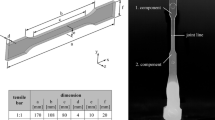Abstract
Micro-injection moulding is one of the key technologies for micro-manufacture because of its mass-production capability and relatively low component cost. The aspect ratios achievable in replicating micro features are one of the most important process characteristics and constitute a major manufacturing constraint in applying injection moulding in a range of micro-engineering applications. This research studies the effects of five process and one size factors on the achievable aspect ratios, and the role they play in producing micro components in different polymer materials. In particular, the following factors are considered: barrel temperature, mould temperature, injection speed, holding pressure, the existence of air evacuation and the sizes of micro features. The study revealed that the barrel temperature and the injection speed are the key factors affecting the aspect ratios of micro features replicated in PP and ABS. In case of POM, in addition to these two factors, the mould temperature is also an important factor for improving the replication capabilities of the micro-injection moulding process. For all three materials, an increase of feature sizes improves the melt flow. However, the melt fill of micro features does not increase linearly with the increase of their sizes.
Similar content being viewed by others
References
Weber L, Ehrfeld W (1999) Micromoulding-market position and development. Kunststoffe 89(10):192–202
Yao D, Kim B (2004) Scaling issues in miniaturization of injection molded parts. Manuf Sci Eng 126:733–739
Mönkkönen K, Hietala J, Paakkonen P (2002) Replication of sub-micron features using amorphous thermoplastics. Polymer Eng Sci 42(7):1600–1608
Zhao J, Mayes RH, Chen G, Xie H, Chan PS (2003) Effects of process parameters on the micro molding process. Polymer Eng Sci 43(9):1542–1554
Yoshii M, Kuramoto H, Kato K (1994) Experimental study of transcription of minute width grooves in injection molding. Polymer Eng Sci 34(15):1211–1218
Wimberger-Friedl R (2001) Injection molding of sub-μm grating optical elements. In: Heim H-P, Potente H (eds) Specialized molding techniques. Plastic Design Library, Norwich, NY, pp 149–155
Yu L, Lee LJ, Koelling KW (2004) Flow and heat transfer simulation of injection molding with microstructures. Polymer Eng Sci 44(10):1866–1876
Arlø UR, Kjær EM (2001) Transcription of small surface structures in injection molding - an experimental study. In: Heim H-P, Potente H (eds) Specialized molding techniques. Plastic Design Library, Norwich, NY, pp 143–147
Shen YK, Yeh SL, Chen SH (2002) Three-dimensional non-newtonian computations of micro-injection molding with the finite element method. Int Comm Heat Mass Transfer 29(5):643–652
Spennemann A, Michaeli W (2001) Process analysis and injection molding of microstructures. In: Heim H-P, Potente H (eds) Specialized molding techniques. Plastic Design Library, Norwich, NY, pp 157–162
Yu L, Koh CG, Lee J, Koelling KW, Madou MJ (2002) Experiment investigation and numerical simulation of injection molding with micro-features. Polymer Eng Sci 42(5):871–888
Shen YK, Wu WY (2002) An analysis of the three-dimensional micro-injection molding. Int Comm Heat Mass Transfer 29(3):423–431
Su YC, Shah J, Lin LW (2004) Implementation and analysis of polymeric microstructure replication by micro injection molding. J Micromech Microeng 14:415−422
Yao D, Kim B (2002) Increasing flow length in thin wall injection molding using a rapidly heated mold. Polymer-Plastics Technol Eng 41(5):819–832
Saito T, Satoh I, Kurosaki Y (2002) A new concept of active temperature control for an injection molding process using infrared radiation heating. Polymer Eng Sci 42(12):2418–2429
Madou MJ (2002) Fundamentals of Microfabrication: the Science of Miniaturization. CRC, Boca Raton
Varadan VK, Jiang XN, Varadan VV (2001) Microstereolithography and other Fabrication Techniques for 3D MEMS. Wiley, Chichester
Montgomery DC (1997) Design and analysis of experiments, 4th edn. Wiley, New York
Bur T, Roth S (2004) The temperature plot of the shear heating at the high shear rate. http://www.brad.ac.uk/acad/ukmig/members/highshear1.htm
Author information
Authors and Affiliations
Corresponding author
Rights and permissions
About this article
Cite this article
Sha, B., Dimov, S., Griffiths, C. et al. Micro-injection moulding: Factors affecting the achievable aspect ratios. Int J Adv Manuf Technol 33, 147–156 (2007). https://doi.org/10.1007/s00170-006-0579-2
Received:
Accepted:
Published:
Issue Date:
DOI: https://doi.org/10.1007/s00170-006-0579-2




